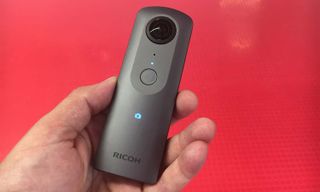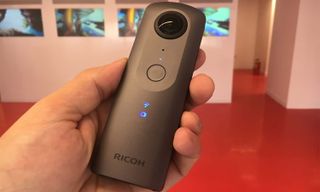Ricoh Theta V 360-Degree Camera Review: Slim Design, Fat Price
This slim 360-degree camera is a cinch to use, but it's expensive for what it offers.
Why you can trust Tom's Guide

Want to take the ultimate selfie? You can use 360-degree cameras to capture photos and videos not just of you, but everything that's happening around you when you press the shutter. Ricoh's latest, the Theta V ($429), is a svelte camera made for impromptu shoots. But while its design and ease of use are top-notch, the Theta V's performance and features don't match those of less-expensive cameras.
Design: Pocket slim
Thereare generally two shapes of360-degree camera: big, square-like devices such as the Garmin Virb 360 that are designed for sports and outdoor activities, and stick-shaped cameras meant for more casual shooters. The Ricoh Theta V falls into the latter category, and does so well; its thin rectangular shape (5.1 x 1.8 x 0.9 inches) slid more easily into my pants pocket than the more bulbous Insta360 One.
At one end of the Theta V are two lenses on opposite sides. Below one of them is a shutter button, as well as some LEDs that let you know if the camera's Wi-Fi is on and whether you're shooting stills or video.
On one of its slim edges, you'll find three smaller buttons: Power, Wi-Fi and Mode (for switching between photos and video). The bottom of the camera has a micro-USB port, a tripod screw mount and a microphone jack.

In all, it's an elegant design; I just wish the Theta V had a microSD card slot. The camera has about 19GB of internal storage, but I prefer the flexibility that comes with removable storage, as you can find on the Samsung Gear 360 and Insta360 One cameras.
Performance
The Ricoh Theta V can record video in 4K and take the equivalent of 14-megapixel photos. While the shots I took with the camera were good, they still took second place to the photos from the Insta360 One.
In a photo I took near New York's Madison Square Park, there was a definite blue cast, which was most evident in the unnaturally vibrant sky. A similar photo taken with the Insta360 One looked much truer to life.
Both cameras washed out the sunlit skyscrapers in the background, but the Insta360 One did slightly better, as seen with the clock tower. The Insta360 One also did a better job of keeping the Flatiron Building looking straight; with the Theta V, the building warped to the left a bit.
The Theta V slid more easily into my pants pocket than the more bulbous Insta360 One.
Underneath a portico, the Theta V did a better job of balancing the exposure and stitching its two images; you can barely see where the two photos meet. In the Insta360 One's photo, however, you can more clearly see where the two halves come together. Overall, though, the Insta360's photo was sharper.
The one issue that kept cropping up with the Theta V — and not with the Insta360 One — was that there was a lot of chromatic aberration with dark images silhouetted against the overcast sky; a number of trees looked purple, rather than black or dark brown.
Apps
Whether you're using Android or iOS, you'll have to download three separate apps to get the most out of the Theta V. Most rival cameras, in contrast, use a single app. With the Theta V, there's the basic app for controlling the camera, an editing app for photos and an editing app for videos.
You'll have to download three separate apps to get the most out of the Theta V.
On a Mac, you have to install the file-transfer app, then use it to move the files from the camera to a folder on your hard drive using that utility, then open them in the Theta Basic app to view the photos. Why should you have to do this? There are no editing tools, either. In comparison, Insta360 One has just one app, through which you can import photos and apply edits, such as removing the purple fringing (chromatic aberration) and fixing stitching issues.
Bottom Line
The Ricoh Theta V is a pretty good 360-degree camera for everyday users. Its design makes it more pocketable than the Insta360 One and the Samsung Gear 360.

However, at $429, it costs more than $100 more than the Insta360 One, which takes more impressive photos, has better software and offers removable storage. The Insta360 One also has a clever "bullet-time" setting, which allows you to make Matrix-style videos.
For those reasons, the Theta V is certainly a good device, but it's not the best 360-degree camera option for casual shooters.
Sign up to get the BEST of Tom’s Guide direct to your inbox.
Upgrade your life with a daily dose of the biggest tech news, lifestyle hacks and our curated analysis. Be the first to know about cutting-edge gadgets and the hottest deals.

Michael A. Prospero is the U.S. Editor-in-Chief for Tom’s Guide. He oversees all evergreen content and oversees the Homes, Smart Home, and Fitness/Wearables categories for the site. In his spare time, he also tests out the latest drones, electric scooters, and smart home gadgets, such as video doorbells. Before his tenure at Tom's Guide, he was the Reviews Editor for Laptop Magazine, a reporter at Fast Company, the Times of Trenton, and, many eons back, an intern at George magazine. He received his undergraduate degree from Boston College, where he worked on the campus newspaper The Heights, and then attended the Columbia University school of Journalism. When he’s not testing out the latest running watch, electric scooter, or skiing or training for a marathon, he’s probably using the latest sous vide machine, smoker, or pizza oven, to the delight — or chagrin — of his family.
